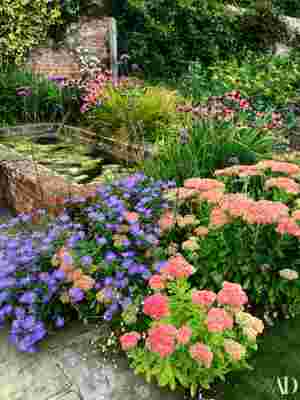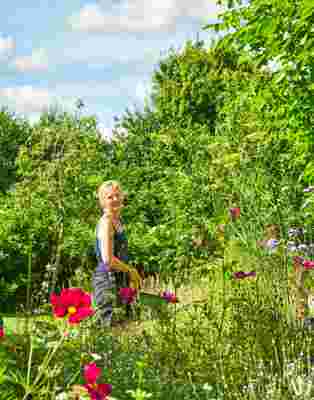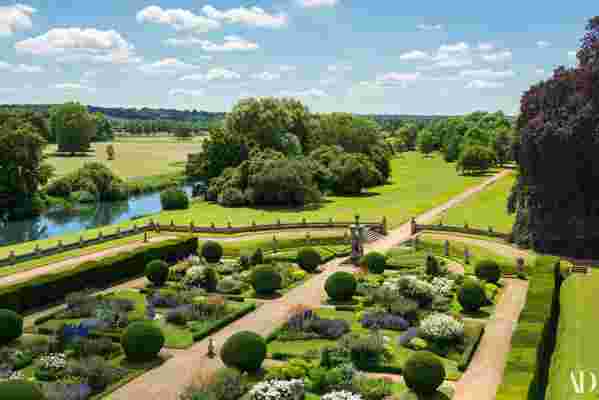As we squelch round her sodden six acres of garden, Lady Tania Compton exclaims, “I love being on clay!” Even though, I ask, it’s awash in winter, is backbreaking to dig, and, come summer, dries to the consistency of concrete? “Totally,” she says. “It’s wonderful!” She’s not joking. Compton—the most successful British landscape designer few have ever heard of—approaches her work with what can only be described as gusto, but that’s just the half of it. Her ebullient attitude is backed up by an encyclopedic knowledge and a willingness to defy conventional wisdom, as in the silver garden that leads to the door of Spilsbury, her house in Wiltshire. Filled with the kinds of Mediterranean plants that drew her into the profession in the first place, the garden entrance gets little sun, yet her lavenders and perovskias still thrive.
Then again, Compton is not exactly a conventional garden designer. An earl’s daughter, she spent her 20s reporting on the Paris party scene for Women’s Wear Daily before relocating to Ibiza in 1985. It was there that, in her own words, she had “the Damascene conversion of my life, from clubbing to cuttings.” Inspired by the spicy scent of helichrysum and the “Guerlain eye-shadow blue” of anchusa, she began to study, absorbing Reverend W. Keble Martin’s classic The Concise British Flora in Colour. A friend put her in touch with the renowned plantswoman Penelope Hobhouse, who invited Compton to spend the summer working in her Somerset garden, leading to meetings with grandes dames like Rosemary Verey and Nancy Lancaster. But all the while Compton was developing her own tastes.

Frikart’s aster, stonecrop, and purple coneflower at Deane House in Hampshire, the grounds of which Compton has tended for the past decade.

The designer at home in the English countryside.
Her decision, in 1988, to sign up for a one-year course at the English Gardening School in London proved fateful. Lancaster predicted she would fall for James Compton, who had been turning heads as the head gardener at the Chelsea Physic Garden, where the school is based. Lancaster was right, and Tania and Jamie wed in 1989, relocating to a village house in Wiltshire with a modest plot that she started tending like mad, simultaneously undertaking her first commissions.
With the arrival of her children, Sophie and Fred, Compton’s design career took a back seat. But upon moving to Spilsbury in 1998 she began transforming what were largely paddocks into an English Eden, with flower-filled meadows, flag-fringed ponds, and a long hazelnut walk underplanted with thousands of spring bulbs. (She also spent ten years as a gardens editor at British House & Garden.) Her friend and professional peer Tom Stuart-Smith describes Spilsbury as “treading, with great flair, that tricky line between simple placemaking and exoticism.”

Deploying vibrant perennials, Compton updated the historic Parterre Garden at Wiltshire’s Longford Castle (subject of Amelia Smith’s new book, Longford Castle: The Treasures & The Collectors).
This floriferous paradise now represents two decades of hard work. It’s both test bed and playground. “People sometimes ask me if I ever sit in it, but for me that’s the whole point,” says Compton. “Falling asleep in a hammock under the old oak tree is tons more fun than digging a border.”
At 54, Compton is now well into the second, post-child-rearing act of her career. For the past ten years she’s been working at Deane House in Hampshire, home to philanthropist Kara Gnodde, who describes the designer admiringly as “a combination of incredibly bossy and incredibly collaborative.” Under her direction the flower garden has been expanded, with a separate cutting garden for the house. “You don’t want a cutting garden to look pretty,” Compton says, “or you’ll only snip at things. You want to be able to fill a room with flowers, not just a posy in a pot.”
This may sound potty, but I call myself a garden dıviner, not a garden designer.
French furniture designer Hervé Van der Straeten, with whom Compton has designed a walled garden in Burgundy, echoes Gnodde’s sentiment, calling his collaborator “charming, bossy, and extremely generous with pragmatic advice. Before meeting her I had no clue there were such plants as Alchemilla mollis or Verbena bonariensis, or that when placing an order, brunnera (small) must not be confused with gunnera (very, very large).”
Layers of flowering tobacco, beeblossom, evening primrose, and cherry laurel bushes at Spilsbury, the English country estate of landscape designer Tania Compton.
At Reddish House, the delectable 18th-century country manse near Salisbury once owned by Cecil Beaton, Compton has been working with current owners David and Sophie Bernstein to return the grounds to their former glory. Asked whether Compton would have got on with the wickedly waspish Beaton, Sophie says, “Tania gets on with everyone, so I have no doubt they would soon be deep in conversation up his ropes of roses on the hillside.” After three years of replanting, Compton discovered from old photographs that much of what she added was in fact there in Beaton’s time. “This may sound potty,” she says, “but I call myself a garden diviner, not a garden designer.”
Her flair for informal exuberance in formal settings is also evident in two other historic Wiltshire gardens. At Longford Castle, a remarkable triangular Elizabethan country house, she worked with the Countess of Radnor to revive an enclosed 19th-century parterre, filling it with perennials in shades of blue, purple, rose, and lilac. Since 2006, closer to home, she has been working on the Arts and Crafts terraces surrounding the Fonthill Estate, home of Lord Margadale, removing leylandii hedges and rescuing heirloom plants and trees. They are now the focus of lush new plantings of cornus, figs, roses, and dianthus.
Compton may be just hitting her stride. Other current commissions include a large town garden for Chris Burch north of Paris and a Gloucester-shire estate for a top-secret client whom she describes, without much exaggeration, as “the coolest woman in Britain.” As for Compton’s place in British horticulture, perhaps the final word should go to Stuart-Smith. “I would say that Tania is one of the central cogs in the world of British gardening, though that seems a very inelegant way of putting it for someone so supremely stylish.”
